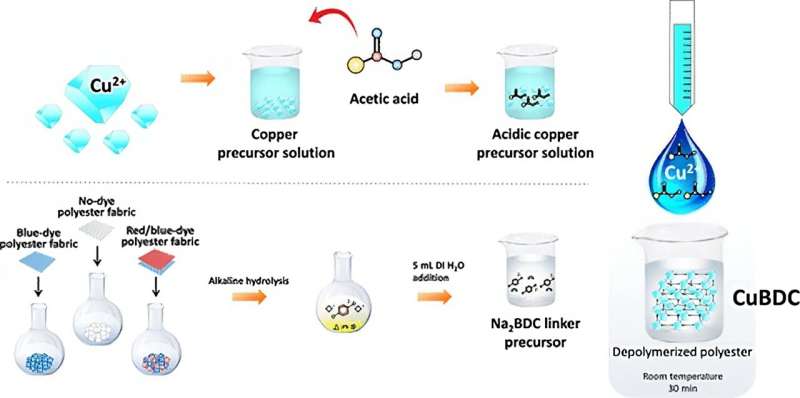This article has been reviewed according to Science X's editorial process and policies. Editors have highlighted the following attributes while ensuring the content's credibility:
fact-checked
peer-reviewed publication
trusted source
proofread
Upcycling method turns textile trash to functional coatings

In an effort to make textiles more sustainable, a new method allows researchers to break old clothing down chemically and reuse polyester compounds to create fire resistant, anti-bacterial or wrinkle-free coatings that could then be applied to clothes and fabrics.
The proof-of-principle study provides hope for unsustainable textile, apparel and footwear industries that together generate 20% of global solid waste. Many so-called recyclers end up illegally dumping textiles as trash in countries in Asia and Africa.
"We think that our clothes are recycled or reprocessed, but most of the time they are actually sent to other places as solid waste," said Juan Hinestroza, the Rebecca Q. Morgan '60 Professor of Fiber Science & Apparel Design and director of the Textiles Nanotechnology Laboratory in the College of Human Ecology. "Our main goal is to offer a pathway to reuse this material."
The paper, "Upcycling of Dyed Polyester Fabrics into Copper-1, 4-Benzeedicarboxylate Metal-Organic Frameworks," published March 30 in the journal Industrial & Engineering Chemistry Research, describes the process of cutting textiles into pieces and chemically decomposing them into a soup of raw materials, dyes, additives, dirt and esters. A metal solution is added and building blocks from the polyester share an affinity with the metal, and selectively link together metal compounds forming tiny cages (called metal-organic frameworks) that settle to the bottom of the soup.
The cages that form are then used to make coatings, which may require minor structural tweaks to tailor each to specific uses. These might include coatings that make permanent press shirts that don't wrinkle, antibacterial surgical gowns or scrubs, or baby or industrial clothes that require a fire-retardant protection.
"One goal of my lab is to create a universal coating that will serve all these purposes, though we are still far away from that," Hinestroza said.
Yelin Ko, a doctoral student in the field of human centered design, is the paper's first author. Prior to this research, some believed the dyes and impurities in the mix would interfere with the process, but this proof-of-principle of the method—known as controlled crystallization—shows that the polyester-derived linkers can seek out and attach to metal compounds in solution, in spite of other present materials.
The research describes a closed loop process, where discarded materials may be reused and contribute to a circular economy—a focus for many sustainability researchers at Cornell, Hinestroza said.
More information: Yelin Ko et al, Upcycling of Dyed Polyester Fabrics into Copper-1,4-Benzenedicarboxylate (CuBDC) Metal–Organic Frameworks, Industrial & Engineering Chemistry Research (2023). DOI: 10.1021/acs.iecr.3c00226
Journal information: Industrial & Engineering Chemistry Research
Provided by Cornell University





















